
In this May 2016 photo released by The Ocean Agency/XL Catlin Seaview Survey, an underwater photographer documents an expanse of dead coral at Lizard Island on Australia's Great Barrier Reef. There were startling colors here just a year ago, a dazzling array of life beneath the waves. Now this Maldivian reef is dead, killed by the stress of rising ocean temperatures. What's left is a haunting expanse of gray, a scene repeated in reefs across the globe in what has fast become a full-blown ecological catastrophe. The world has lost roughly half its coral reefs in the last 30 years. Scientists are now scrambling to ensure that at least a fraction of these unique ecosystems survives beyond the next three decades. The health of the planet depends on it: Coral reefs support a quarter of all marine species, as well as half a billion people around the world. “This isn't something that's going to happen 100 years from now. We're losing them right now”, said marine biologist Julia Baum of Canada's University of Victoria. “We're losing them really quickly, much more quickly than I think any of us ever could have imagined”. Even if the world could halt global warming now, scientists still expect that more than 90 percent of corals will die by 2050. Without drastic intervention, we risk losing them all. “To lose coral reefs is to fundamentally undermine the health of a very large proportion of the human race”, said Ruth Gates, director of the Hawaii Institute of Marine Biology. Coral reefs produce some of the oxygen we breathe. Often described as underwater rainforests, they populate a tiny fraction of the ocean but provide habitats for one in four marine species. Reefs also form crucial barriers protecting coastlines from the full force of storms. They provide billions of dollars in revenue from tourism, fishing and other commerce, and are used in medical research for cures to diseases including cancer, arthritis and bacterial or viral infections. Corals are invertebrates, living mostly in tropical waters. They secrete calcium carbonate to build protective skeletons that grow and take on impressive colors, thanks to a symbiotic relationship with algae that live in their tissues and provide them with energy. But corals are sensitive to temperature fluctuations, and are suffering from rising ocean temperatures and acidification, as well as from overfishing, pollution, coastal development and agricultural runoff. A temperature change of just 1 to 2 degrees Celsius (1.8 to 3.6 degrees Fahrenheit) can force coral to expel the algae, leaving their white skeletons visible in a process known as “bleaching”. Bleached coral can recover if the water cools, but if high temperatures persist for months, the coral will die. Eventually the reef will degrade, leaving fish without habitats and coastlines less protected from storm surges. (Photo by The Ocean Agency/XL Catlin Seaview Survey via AP Photo)

This combination of two photos taken in March and May 2016 released by The Ocean Agency/XL Catlin Seaview Survey shows bleached coral, left, and the same coral which has died in Lizard Island on Australia's Great Barrier Reef. Coral reefs, unique underwater ecosystems that sustain a quarter of the world's marine species and half a billion people, are dying on an unprecedented scale. Scientists are racing to prevent a complete wipeout within decades. (Photo by Richard Vevers and Christophe Bailhache/The Ocean Agency/XL Catlin Seaview Survey via AP Photo)
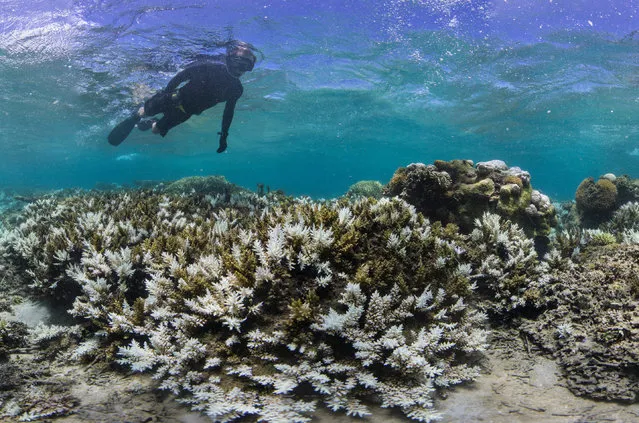
In this March 2016 photo released by The Ocean Agency/Reef Explorer Fiji, a snorkeler swims above coral that has bleached white due to heat stress in Fiji. (Photo by Victor Bonito/The Ocean Agency/Reef Explorer Fiji via AP)
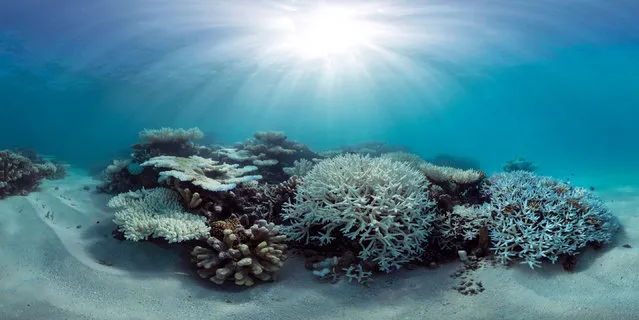
This May 2016 photo released by The Ocean Agency/XL Catlin Seaview Survey shows coral that has bleached white due to heat stress in the Maldives. (Photo by The Ocean Agency/XL Catlin Seaview Survey via AP Photo)
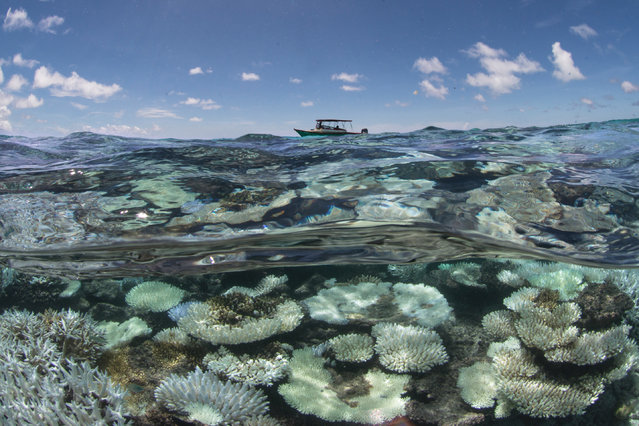
In this May 2016 photo released by The Ocean Agency/XL Catlin Seaview Survey, a boat sails near a coral reef that has been bleached white by heat stress in the Maldives. (Photo by The Ocean Agency/XL Catlin Seaview Survey via AP Photo)
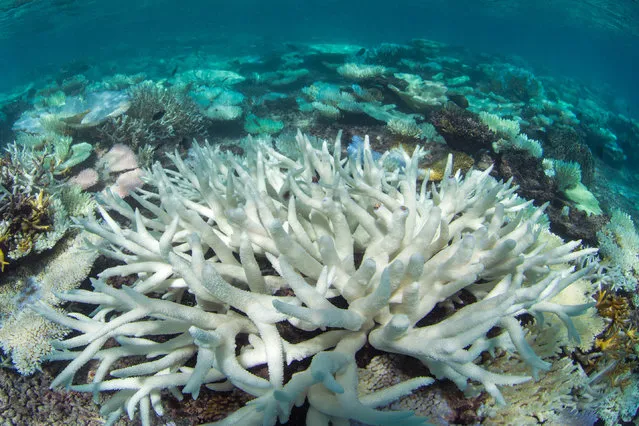
This May 2016 photo provided by the Ocean Agency/XL Catlin Seaview Survey shows coral bleaching in the Maldives. (Photo by The Ocean Agency/XL Catlin Seaview Survey via AP Photo)
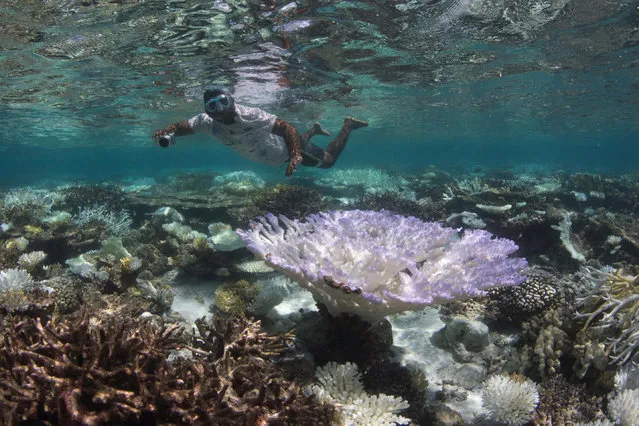
This May 2016 photo provided by the Ocean Agency/XL Catlin Seaview Survey shows a snorkeler surveying the coral bleaching in the Maldives. (Photo by The Ocean Agency/XL Catlin Seaview Survey via AP Photo)
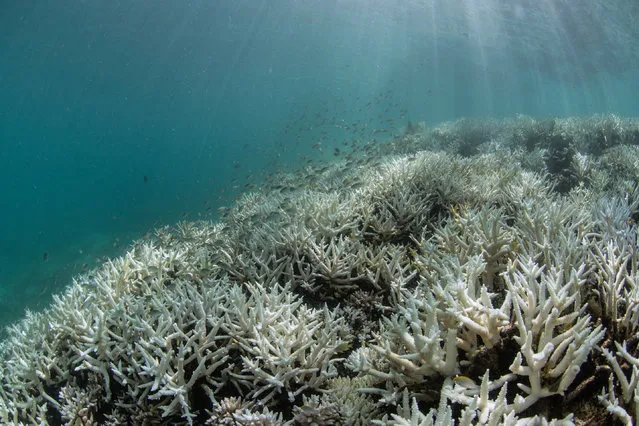
This March 2016 photo released by The Ocean Agency/XL Catlin Seaview Survey shows coral bleached white by heat stress in New Caledonia. (Photo by The Ocean Agency/XL Catlin Seaview Survey via AP Photo)
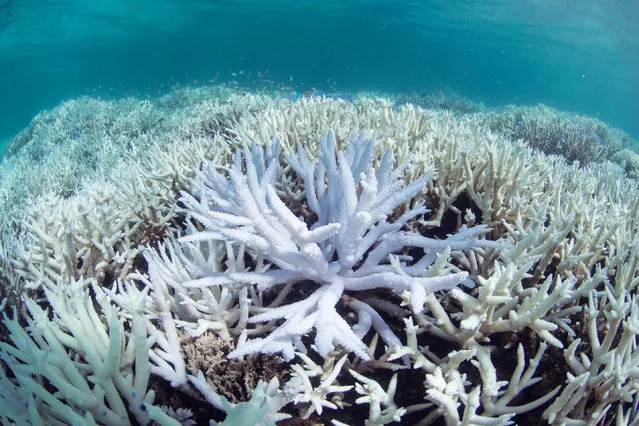
This March 2016 photo released by The Ocean Agency/XL Catlin Seaview Survey shows coral bleached white by heat stress in New Caledonia. (Photo by The Ocean Agency/XL Catlin Seaview Survey via AP Photo)
14 Mar 2017 00:05:00,
post received
0 comments
